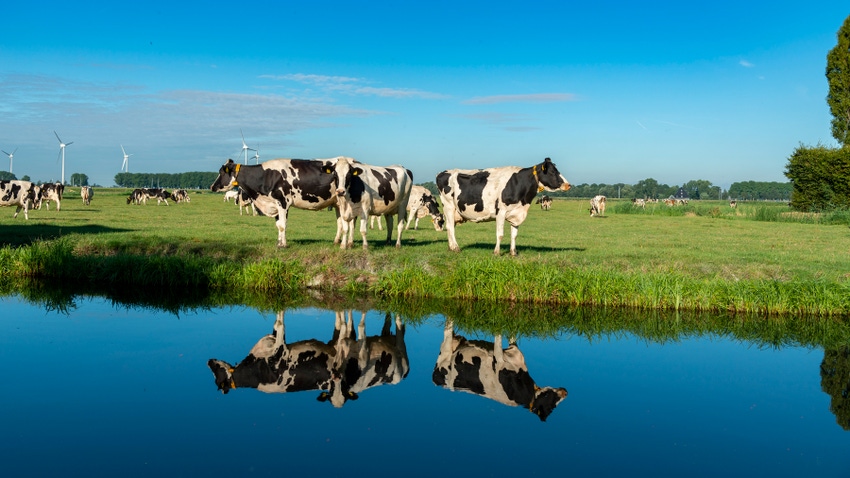
It seems as though fingers are pointed directly at the dairy industry, as cows are blamed for all things wrong with the environment.
“Yes, cows do produce methane, which is one of the greenhouse gases,” says Erin Cortus, University of Minnesota associate professor and Extension engineer, “but it is not the only source of greenhouse gases.”
Justified or not, the dairy industry feels the finger-pointing, and the need to address those concerns — but it will take a full-team approach. A collaboration of dairy organizations has initiated the U.S. Dairy Net Zero Initiative aiming to advance research, on-farm pilots and new market development to make sustainable practices accessible for dairy farms of all sizes.
Cortus has been working with Midwest Dairy for a couple of years, starting with conversations about sustainability and what the NZI means. “And how do we start thinking about how that applies to individual farms, individual farmers and those that we work with?” she says. “As we’ve moved forward, we see some merit in applying some baseline metrics to really get these conversations moving further and faster.”
A lot of the conversations today focus on sustainability, for which Cortus admits there is no single definition that suits every dairy producer. A farm’s vision is a starting point.
“I like to understand: What is that long-distance goal for the person that I’m working with? What do they see as the necessary situation or the necessary place for something to be sustainable?” she says. “We all have different paths we can travel to get there. I liken sustainability — or putting together sustainability plans, sustainability goals or sustainability frameworks — as a long-distance road trip. It takes planning, and then it takes implementation.”
Net-zero by ’50
The dairy industry’s road trip has its sight set on 2050, with the goal for U.S. dairy to achieve greenhouse gas neutrality, optimize water use while maximizing recycling and improve water quality.
Cortus feels Midwest livestock producers have advantages over other regions. “Whether it’s a dairy farm or swine farm or poultry farm, we have our feed production close to our livestock production. And we have those complementary agricultural industries that support our production. In other areas of the country, our feed production for animals might not be next door.”
Another bonus of livestock being raised near where feed sources originate, even though not necessarily under the same ownership, is, “That allows us to track how we recycle manure back to our crops,” she says.
She stresses that producers have and should continue to implement best management practices for manure application, “and in that recycling of the manure, we have the potential to offset use of commercial fertilizers,” further reducing the carbon footprint.
This is happening, but Cortus says, “We need to figure out some better ways to document how we’re doing. That is one thing I foresee as a challenge — maybe on the research side, maybe on the implementation side — but how can we track that a little bit better to gain that benefit in some of our impact assessments?”
Manure handling technology
As an Extension engineer, Cortus approaches her work by laying out the options available to farmers. “It’s important that we lay out, within all those different options, as many of those knowns and unknowns for any technology.”
As an example, with manure storage, she says there’s some evidence that the longer manure is stored, the longer that environment for anaerobic decomposition and methane production builds up. “That suggests that removing manure more frequently from a storage system can reduce greenhouse gas emissions, or at least methane emissions,” she says. “However, we also recognize that it’s not always beneficial to apply manure through the year. We want to retain those nutrients on the field, and so we apply when the crop can use it best to avoid losses — especially due to weather.”
Just as not all producers have the same definition for sustainability, Cortus says, “I’ve never seen one technology that that checks every single box to the max. By that, I mean emissions, manure management considerations or application considerations and cost.”
Putting numbers behind practices is what Cortus hopes to do with the next phase of her research. “I have a couple different research projects going on to try and fill in some of these gaps that we’ve seen. Are there some sampling techniques on farm that aren't too onerous? Are there some sampling techniques that we can do on-farm to try and give us a better idea of a specific farm’s methane emissions from the manure storage.”
To that end, sampling of feed and manure can help researchers and farmers fine-tune measurements to get to a point where individual farms have emissions estimates relative to just a generic estimate.
“We’re looking at different tests that we can do for that. We’re comparing them to some aerial measurements from farms to pull together different ways that we can try and look at both what the emissions are from our Midwest farms — and then down the road, what can we do to potentially change them?” she says.
Is net-zero possible?
Cortus says studies show that the dairy industry has the potential to be net-zero, but not without changes.
“It’s possible — but for that to happen, it requires action by farms of all shapes and sizes,” she says. “It may require some farms to look at our current manure treatment technologies that turn methane into something more useful. Or, reducing some of that enteric methane through feed additives, when additives are fully tested.”
On the crop side, she says there are practices that can be implemented to reduce tillage to increase that carbon store and then offset nitrogen fertilizer use.
About the Author(s)
You May Also Like






